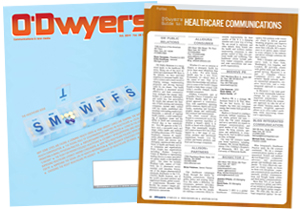 O'Kane
|
Today, more than half of the world's population lives in cities. By 2050, that number is expected to rise to two-thirds. Nearly one in eight urbanites now live in "megacities," defined as having 10 million or more inhabitants. The rise of megacities will tax medical infrastructure in many societies, and will no doubt herald a flood of healthcare challenges some will be poorly equipped to handle.
Fortunately, the PR industry has the ability and tools to help mitigate these challenges.
Radical urbanization has been underway in the western world for 200 years. As the Industrial Revolution replaced manual labor with manufacturing, jobs attracted people and cities grew exponentially.
Then as now, cities offered the hope of higher standards of living, higher incomes and better access to education, social services and healthcare. "Megacities" once referred only to New York, Tokyo and Mexico City, urban areas whose populations exploded over a period of decades. Today's megacities are emerging in less developed countries, according to the United Nations' 2011 World Urbanization Prospects: by 2030, there will be 41 megacities, seven of them in China alone.
Impact on health
Health threats in megacities are hard to quantify but impossible to ignore. Three that warrant particular attention because of their scope and long-range effects are air pollution, climate change and mental stress.
|
|
Globally, air pollution is the most important environmental health risk, contributing to approximately 3.3 million deaths annually, according to the World Meteorological Organization's study "Megacities and Urban Complexes." In many megacities, the increasing levels of health-damaging pollutants far outpaces use of pollution-reduction measures.
Experts also predict climate change will affect hundreds of millions of people living in cities over the next decade. Heat stress, extreme precipitation, flooding, drought and water scarcity caused by global warming pose unprecedented risks to large urban areas, according to the Intergovernmental Panel on Climate Change (IPCC).
Finally, there's mental stress. In crowded areas, individuals have less control over their environments, and social disparities are exacerbated. One study, "Urban Stress and Mental Health," reported by the London School of Economics and Political Science's LSE Cities project, showed urban dwellers have a 20% higher risk of developing anxiety disorders, a 40% higher risk of developing mood disorders and double the risk of developing schizophrenia.
PR uniquely suited to help public health
Megacities will test the wisdom and efficacy of healthcare policies adopted by different countries. We believe health communicators' expertise and skills can make a meaningful difference. Here are some of the strategies and challenges that megacities call into play.
Providing medical services to socially, culturally and physically diverse populations requires deep insights and tailored communications. In a complex, culturally diverse environment, insightful, relevant and measurable communications are critical for any company or organization connecting with specific populations.
The fact that a message is aimed at an enormous audience does not mean each message must be backed by an enormous campaign. Often, reaching fewer consumers with a tailored message better facilitates behavior change. In West Africa, we can observe this principle as Liberia struggles to respond to the ongoing Ebola outbreak. The disease has taken a terrible toll on the nation's public health community, which must make the most of extremely limited resources. Because only 43% of the population is literate — and because nearly half of the population is under the age of 18 — any effective campaign would have to "speak" to young people in a multimedia format. Health authorities decided that music could be a powerful medium. They embedded advice about how to combat contagion in Hip-Co songs, a blend of U.S.-style hip-hop and the colloquial English dialect that appeals to young Liberians.
The songs, played on Liberian television and radio stations, carried warnings about how the disease is spread and the best thinking on how individuals can protect themselves. The campaign illustrates one way to communicate creatively, under dire budget and resource constraints, in a language the audience understands.
Communications professionals, government officials, corporations and third parties must collaborate to address major public health issues. By definition, PR campaigns are conceived and crafted to persuade stakeholders to act. There is always an emphasis on collaboration. In megacities, whose heterogeneous populations outnumber those of many countries, consensus-building is all the more important. Communications professionals working in these environments may find that more energy and time will be consumed in sowing consensus among consumers, care providers, government officials, business leaders and health insurers. Understanding this necessity, communicators can adjust priorities, budgets and timetables.
Our role as health communicators is to crystallize our clients' visions and identify advocacy partners to advance their causes. By uniting clients with others that share their passion and drive, we can create partnerships that drive innovative and practical strategies to combat health problems.
Measureable outcomes define success. The health industry is awash in data. Many experts say that our health systems are not making good use of this resource today, in part because systems lack "interoperability," and also because the objectives are fuzzy. As we move toward a future in which megacities are the dominant modality, we must harness data in more effective ways.
In planning a campaign, data analysis will help us address the fact that disease outbreaks and epidemics of chronic illness propagate across multiple locations, populations and points in time. If you think of today's PR campaigns as structured on two axes, location and time, then healthcare campaigns in a megacity of the mid-century will be plotted on exponentially more. That's because, on today's campaign map, the data we can predict or glean are only loosely linked to population psychology, perceptions, attitudes and predispositions. In a few short decades, each of these dimly-grasped determinants will be incorporated into the campaign and analyzed as data sets. The goal will be understanding, predicting, measuring and responding to the multi-axis triggers and determinants of disease and health.
The role of health communications is to educate consumers, healthcare providers and public officials to help them make good decisions, and to influence their attitudes and perceptions of vital health issues. In the age of megacities, the intersecting planes of crisis and response are radically transformed but the mission remains. Communicating with efficiency and relevance to target audiences is the only correct course.
* * *
Jeanine O'Kane is managing director of Biosector 2, part of Chandler Chicco Companies.



 Lo Isidro, senior director at Real Chemistry with more than a decade of strategic communications and PA experience, has joined Narrative Strategies.
Lo Isidro, senior director at Real Chemistry with more than a decade of strategic communications and PA experience, has joined Narrative Strategies. Nelson Fernandez, former North American chair of APCO Worldwide and managing director of Burson-Marsteller, has joined Volunteers in Medicine Berkshires as director of communications and PA.
Nelson Fernandez, former North American chair of APCO Worldwide and managing director of Burson-Marsteller, has joined Volunteers in Medicine Berkshires as director of communications and PA. Lilit Bargar, who was most recently an EVP in the healthcare practice at Weber Shandwick, comes on board at GCI Health as EVP, corporate practice lead.
Lilit Bargar, who was most recently an EVP in the healthcare practice at Weber Shandwick, comes on board at GCI Health as EVP, corporate practice lead.
 Five ways that successful thought leaders are made.
Five ways that successful thought leaders are made.


 Have a comment? Send it to
Have a comment? Send it to 
No comments have been submitted for this story yet.